Undergraduate Opportunities
DTS
The Diagnostic Testing Services section (DTS) at the CVMDL consists of three laboratory sections- descriptions and opportunities are described below:
All three lab sections will provide unique, hands-on experiences in learning how to perform the procedures described and interpret the results, in addition to learning the daily upkeep to maintain a laboratory.

This lab section consists of bacteriology, parasitology, and mastitis areas. Bacteriology isolates and identifies bacteria from clinical samples collected and submitted by private veterinarians and from necropsy cases. Parasitology uses qualitative and quantitative methods to identify eggs and worms from fecal samples. Mastitis is inflammation of the mammary gland. This lab area receives milk samples from dairy farms. It utilizes methods (gram stain, culture, OmniLog, etc) to determine if the cow is mastitic (elevated cell count) and cultures the milk to isolate the bacteria.
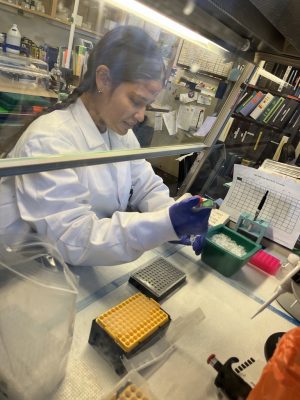 Molecular tests for tick-borne diseases, avian influenza, West Nile Virus, COVID-19, and other pathogens using quantitative and conventional PCR. In this lab, you will learn RNA and DNA extraction procedures from different specimens. Also, there will be training on how to run conventional and real-time PCR. This section also has a start-up Next Generation Sequencing lab.
Molecular tests for tick-borne diseases, avian influenza, West Nile Virus, COVID-19, and other pathogens using quantitative and conventional PCR. In this lab, you will learn RNA and DNA extraction procedures from different specimens. Also, there will be training on how to run conventional and real-time PCR. This section also has a start-up Next Generation Sequencing lab.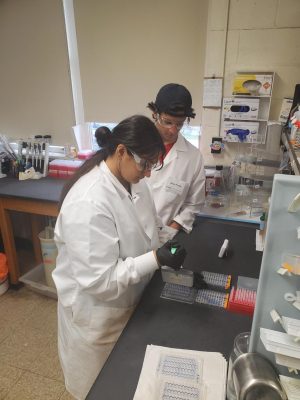
Serology is a field that utilizes numerous assays to detect antibodies against a wide variety of antigens. Some of the methodologies include ELISA, Western blot, IFA, and plate agglutination to detect antibodies against Salmonella, Borrelia burgdorferi, Pseudorabies, and Avian Influenza. Additionally, students will expect to gain extensive experience with micro and serological pipetting and the use of laboratory equipment, like centrifuges and ELISA plate readers.
Additional opportunities
Other activities in DTS exist for cross-training.
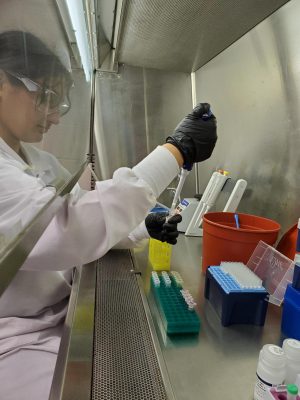 Ticks: The CVMDL has a tick testing laboratory, and students could have the opportunity to learn how to identify ticks. Identifying ticks includes determining species, life stages, and degree of engorgement.
Ticks: The CVMDL has a tick testing laboratory, and students could have the opportunity to learn how to identify ticks. Identifying ticks includes determining species, life stages, and degree of engorgement.
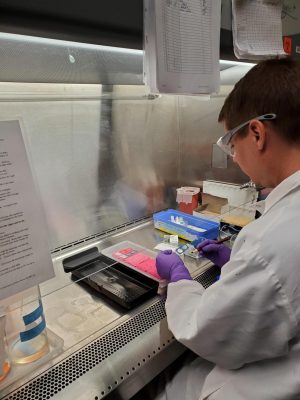 Rabies: This is an opportunity for students to perform the DFA procedure to aid in the post-mortem diagnosis of the rabies virus in clinically ill animals. NOTE: only those who have been vaccinated against rabies and have protective immunity are allowed to perform this testing.
Rabies: This is an opportunity for students to perform the DFA procedure to aid in the post-mortem diagnosis of the rabies virus in clinically ill animals. NOTE: only those who have been vaccinated against rabies and have protective immunity are allowed to perform this testing.
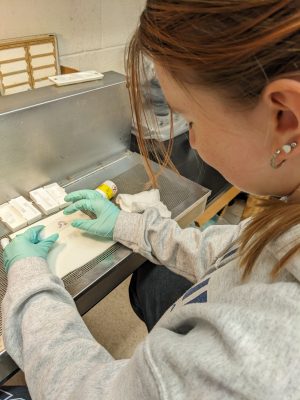
The Histology Laboratory is responsible for processing tissue pieces from necropsy, surgery, or biopsy into microscope slides for review and diagnosis by a Pathologist. Additionally, the laboratory performs special stains and Immunohistochemistry for the detection of infectious organisms, cell and tissue identification, and disease processes.
As an independent study student, you will learn basic tasks and manual and automated techniques in general laboratory operations such as coverslipping, embedding of sections, archiving of diagnostic materials and documents, simple staining procedures, and equipment cleaning and maintenance.
Please be aware that the core tasks of a histology laboratory are typically completed during the morning hours. To have a meaningful experience, you will need to be available between 8:00 and 12:00 pm.
Pathology ties together the fundamental concepts of biology, disease, and one health; each section will provide a unique, hands-on experience in learning how to perform the procedures described and learning the daily upkeep to maintain a safe and effective laboratory.
The Pathology section at the CVMDL consists of three laboratory sections-descriptions and opportunities are described below:
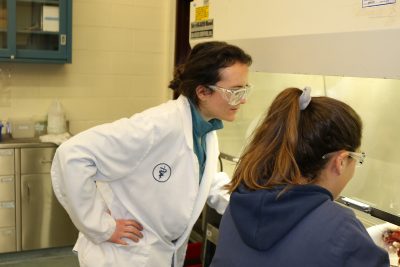 Necropsy: A necropsy is the post-mortem examination of any animal species. In this lab, students learn how to be a prosector’s assistants across a wide range of species and cases. Students will gain experience in sample collection, tissue identification, and lesion identification. Additionally, students will gain experience maintaining a safe and functional laboratory space.
Necropsy: A necropsy is the post-mortem examination of any animal species. In this lab, students learn how to be a prosector’s assistants across a wide range of species and cases. Students will gain experience in sample collection, tissue identification, and lesion identification. Additionally, students will gain experience maintaining a safe and functional laboratory space.
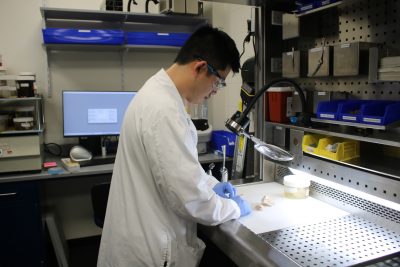 Trimming: Trimming is the process of cutting fixed tissues collected at necropsy down into cassettes. From there, the cassettes are made into blocks, which are then made into slides for the pathologists to read. In this lab, students learn trimming techniques, tissue identification, and lesion identification. Additionally, students will gain experience maintaining a safe and functional laboratory space.
Trimming: Trimming is the process of cutting fixed tissues collected at necropsy down into cassettes. From there, the cassettes are made into blocks, which are then made into slides for the pathologists to read. In this lab, students learn trimming techniques, tissue identification, and lesion identification. Additionally, students will gain experience maintaining a safe and functional laboratory space.